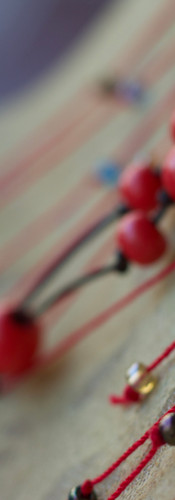The Woman
- D.C.Thomas
- Oct 9, 2020
- 2 min read
Updated: May 30, 2025
The Woman
Life, Maiden, Mother, Warrior, Guardian
I have been living through the last years of my twenties honoring my mixed ancestry.
This art installation focuses on the inspiration I drew from the Praetorian Guard armor, from Ancient Rome, applied in a contemporary context of honoring my matrilineal kinship.
Using organic materials such as wood, paper, cotton, leather, wool, and dry leaves, I have assembled an armor that will not withstand time in the same way the strength of my family has. This Lorica Segmentata-influenced assemblage is an ephemeral collection of art items about the women from whom I draw my breath, and my existence.
These women belonged to Dacian, Thracian, and Greek tribes, they endured the Roman invasion and occupation of the Ancient Dacian Kingdom (Romania today), women who lived through the Ottoman and Russian occupations, women who survived World Wars, women who worked the fields in the countryside and passed on ancient traditions and customs to their daughters.
Out of all cross variants, I chose to embroider the equal length cross - the Greek cross - on Italian cross stitch fabric, which was a gift from a very good friend from Europe, and a US-based fine artist. Various crosses were used in heraldry and, in this installation, my scutum channels the teachings of my grandmother, who put the needle in my hand at six years old and taught me how to cross-stitch embroider with a fiery red thread.
Drawing life from the same woman, the cross insignia pertains not only to the religious background of my upbringing but it is also meant to reference the medical field in which my mother works for a living, especially in the dire circumstances due to the COVID-19 pandemic.
As mentioned above, this art installation is meant to evoke the strength of my matrilineal kinship, and its heritage also, through the usage of techniques, tools, and elements that are ephemeral, in contrast to the strength that is perpetuated from mother to daughter, grandmother to granddaughter and so on.
In the same way, teachings pertaining to embroidery, sewing, knitting, and adorning have also been passed on out of the need for preserving one’s cultural history, the need for warmth during the harsh winters in Romania, and/or for dowry practices.
The dowry, in Romania, served as legal empowerment for women - in the long run - as this practice helped ensure economic security for divorced women, widows, or children resulting from their marriage.
In this context, men had no right to the valuable homemade dowry items the bride brought into the marriage (often consisting of necklaces or belts made of genuine gold and/or silver coins, embroidered and hand-sewn clothing made of precious fabrics or wool, pelts, shoes and more).
D.C.Thomas















Comments